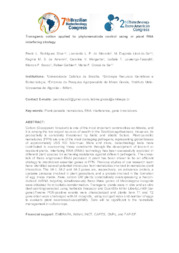Transgenic cotton applied to phytonematode control using in plant RNA interfering strategy.
Transgenic cotton applied to phytonematode control using in plant RNA interfering strategy.
Author(s): SILVA, P. L. R.; MACEDO, L. L. P. de; SÁ, M. E. L. de; AMORIM. R. M. S. de; MORGANTE, C. V.; TESSUTTI, I. T. L.; BASSO, M. F.; GALBIERI, R.; SÁ, M. F. G. de
Summary: Cotton (Gossypium hirsutum) is one of the most important commodities worldwide, and it is among the ten largest sources of wealth in the Brazilian agribusiness. However, its productivity is constantly threatened by biotic and abiotic factors. Plant-parasitic nematodes (PPN) are one of the most damaging pathogens, representing global losses of approximately US$ 100 bi/annual. More and more, biotechnology tools have contributed to overcoming these constraints through the development of tolerant or resistant plants. Interfering RNA (RNAi) technology has been successfully exploited in different plant species for achieving resistance against different pathogens. The cross-talk of these engineered RNAi produced in planthas been shown to be an efficient strategy to knockdown essential genes in PPN. Previous studies of our research team have identified several potential molecules from nematodes involved in nematode-plant interaction. The Mi-1, Mi-2 and Mi-3 genes are, respectively, an avirulence protein, a cysteine protease involved in plant parasitism, and a protein involved in the formation of egg mass matrix. Here, cotton GM plants constitutively overexpressing a hairpin-derived dsRNA targeting simultaneously these three genes of Meloidogyne incognita were obtained from biolistic-transformation. Transgenic plants were in vitro and ex vitro (leaf-painting) selected using herbicide Imazapyr and QuickStix kit for LibertyLink® (bar gene).Twelve PCR-positive events were characterized and plants from T1 and T2 generation were challenged with M. incognita, using root gall index and number of eggs to evaluate plant resistance/susceptibility. Data will be significant to the nematode management in cotton crops.
Publication year: 2018
Types of publication: Abstract in annals or event proceedings
Unit: Embrapa Semi-arid Region
Observation
Some of Embrapa's publications are published as ePub files. To read them, use or download one of the following free software options to your computer or mobile device. Android: Google Play Books; IOS: iBooks; Windows and Linux: Calibre.
Access other publications
Access the Agricultural Research Database (BDPA) to consult Embrapa's full library collection and records.
Visit Embrapa Bookstore to purchase books and other publications sold by Embrapa.

